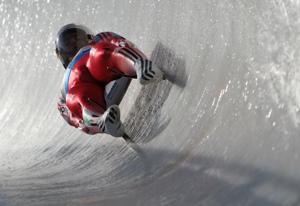Rules of Luge

Luge is a winter racing sport that involves riding sleds down an artificial tracks built with steep banks and inclines. Participating athletes position themselves in a “supine” position whilst riding the sleds (lying down on their backs facing upwards with their feet at the bottom).
There is evidence to suggest that Luge races may have been held as long ago as 800 AD with Vikings using sleds to compete against one another on the Oslofjord mountains. The first confirmed and recorded international Luge event was held in 1883, with seven nations competing in Davos, Switzerland.
Luge made its very first appearance at the Olympics back in 1964, and has remained ever-present since. Germany is the leading Nation in Olympic Luge in all events, including Men’s Singles, Doubles and Women’s Singles. Italy and Austria are the closest rivals, although remain someway behind.
Georg Hackl, Jan Behrendt and Stefan Krausse are three of Germany’s top Luge athletes, but the most successful individual in the sport to date is Italy’s Armin Zoggeler with 2 gold, 1 silver and 3 bronze medals overall.
Object of the Game
The object of Luge is to reach the end of the track in the fastest time possible.
Luge involves individual races and two-man team races, with athletes required to use their shoulders, abdominal and thigh muscles to control the pace and direction of the sled. Every individual or team competes one at a time, racing against a clock.
The athlete/team that records the fastest overall time over a series of “runs” is declared the winner.
Players & Equipment
The main piece of equipment involved in a Luge race includes the racing sled. Athletes are also required to wear certain garments, and will need to initiate particular techniques in order to complete the track at the fastest speed possible whilst remaining safe.
Sled
Athletes and their coaching teams have to keep their sleds in the best possible condition in order to stand a chance of winning a Luge competition. This includes making regular alterations to make the sled as aerodynamic as possible. There are restrictions on sled design, which can be found in the “rules” section below.
Protective Clothing:
Luge is considered by many as an “extreme sport”, and as a result, comes with a wide variety of risks and hazards that organisations must do their best to minimise in order to preserve the participating athletes’ safety. Protective clothing is required to run a Luge race, with all competitors wearing a helmet and visor in order to keep their head safe when racing around the track. A skin-tight rubber suit is also worn to improve aerodynamics, whilst spiked gloves are used so athletes can position themselves on the track at the starting line. Specially designed racing boots also help to keep feet and legs locked in the straight position.
Ability
Professionals Luge athletes often train for over a decade in order to master the skills and techniques required in order to compete at the very top level (such as at the Olympics). Their bodies must be in fine form in order to steer their sleds at high velocity, with shoulders, abdominals, calves and quads all crucial to controlling the position of the sled when on the track.
Scoring
Scoring in Luge is calculated by counting the total time it takes for an athlete or team to complete a pre-determined number of “runs” (a “run” means completing the track from start to finish). All races are timed to a thousandth of a second. This puts Luge among some of the most accurately timed sports on the planet.
Winning
In Luge, the overall winner is determined over a series of runs. The number of runs permitted varies depending on the nature of the event. Each athlete/team has their runs added together and the total time is calculated. The person/people with fastest time is/are declared the winner(s).
Rules of Luge
The rules of Luge vary depending on the type of event being held.
- In singles tournaments, all competing athletes are allowed to take four separate runs down the track. In doubles tournaments, teams of two take two runs down the Luge track.
- At the beginning of each run, the Luge sleds are weighed and examined by officials. This is to determine whether the sled falls line with rules and regulations. If the sled fails to meet these requirements, athletes riding will be disqualified. Athletes themselves are also weighed, and may be able to add weight in certain instances as ballast.
- In both singles and doubles events, competitors are divided into four starting groups. The running order changes depending on finishing times.
- A final check known as “sled control” is also conducted after all four runs have been completed to ensure no alterations have been made by teams or athletes. Any sled that fails these checks will see athletes disqualified.